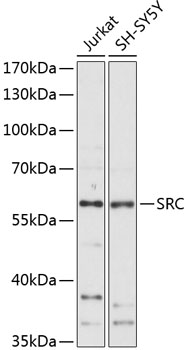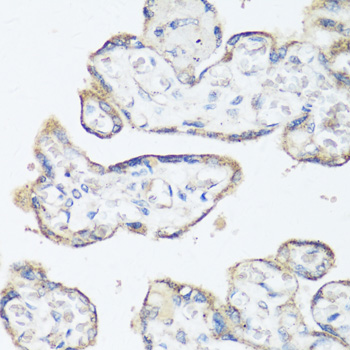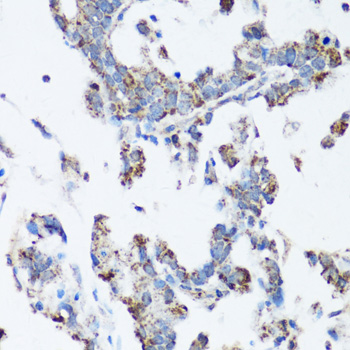Anti-SRC Antibody (CAB11707)
- SKU:
- CAB11707
- Product type:
- Antibody
- Reactivity:
- Human
- Mouse
- Rat
- Host Species:
- Rabbit
- Isotype:
- IgG
- Antibody Type:
- Polyclonal Antibody
- Research Area:
- Cell Biology
Description
| Antibody Name: | Anti-SRC Antibody |
| Antibody SKU: | CAB11707 |
| Antibody Size: | 20uL, 50uL, 100uL |
| Application: | WB IHC IF |
| Reactivity: | Human, Mouse, Rat |
| Host Species: | Rabbit |
| Immunogen: | Recombinant fusion protein containing a sequence corresponding to amino acids 1-80 of human SRC (NP_005408.1). |
| Application: | WB IHC IF |
| Recommended Dilution: | WB 1:500 - 1:2000 IHC 1:50 - 1:200 IF 1:50 - 1:200 |
| Reactivity: | Human, Mouse, Rat |
| Positive Samples: | Jurkat, SH-SY5Y |
| Immunogen: | Recombinant fusion protein containing a sequence corresponding to amino acids 1-80 of human SRC (NP_005408.1). |
| Purification Method: | Affinity purification |
| Storage Buffer: | Store at -20°C. Avoid freeze / thaw cycles. Buffer: PBS with 0.02% sodium azide, 50% glycerol, pH7.3. |
| Isotype: | IgG |
| Sequence: | MGSN KSKP KDAS QRRR SLEP AENV HGAG GGAF PASQ TPSK PASA DGHR GPSA AFAP AAAE PKLF GGFN SSDT VTSP QRAG |
| Gene ID: | 6714 |
| Uniprot: | P12931 |
| Cellular Location: | Cell membrane, Cytoplasm, Mitochondrion inner membrane, Nucleus, cytoskeleton |
| Calculated MW: | 59kDa/60kDa |
| Observed MW: | 60kDa |
| Synonyms: | ASV, SRC1, THC6, c-SRC, p60-Src, SRC |
| Background: | This gene is highly similar to the v-src gene of Rous sarcoma virus. This proto-oncogene may play a role in the regulation of embryonic development and cell growth. The protein encoded by this gene is a tyrosine-protein kinase whose activity can be inhibited by phosphorylation by c-SRC kinase. Mutations in this gene could be involved in the malignant progression of colon cancer. Two transcript variants encoding the same protein have been found for this gene. |
| UniProt Protein Function: | Src: proto-oncogenic cytoplasmic tyrosine kinase of the SRC family. Highly expressed in certain fully differentiated cells such as neurons, platelets and macrophages. Phosphorylation of an activation loop tyrosine activates the enzyme; phosphorylation of a tyrosine in the C-terminus by Csk inhibits the enzyme. Two alternatively spliced isoforms have been described. |
| UniProt Protein Details: | Protein type:Oncoprotein; Protein kinase, tyrosine (non-receptor); Kinase, protein; EC 2.7.10.2; Protein kinase, TK; TK group; Src family Chromosomal Location of Human Ortholog: 20q12-q13 Cellular Component: neuron projection; mitochondrion; lysosome; postsynaptic density; actin filament; caveola; cytosol; extrinsic to internal side of plasma membrane; perinuclear region of cytoplasm; late endosome; mitochondrial inner membrane; cytoplasm; plasma membrane; nucleus Molecular Function:protein C-terminus binding; ephrin receptor binding; non-membrane spanning protein tyrosine kinase activity; phosphoprotein binding; insulin receptor binding; protein kinase activity; integrin binding; protein binding; enzyme binding; SH3/SH2 adaptor activity; protein kinase C binding; protein-tyrosine kinase activity; heme binding; estrogen receptor binding; SH2 domain binding; kinase activity; ATP binding; receptor binding; hormone receptor binding Biological Process: oogenesis; regulation of estrogen receptor signaling pathway; estrogen receptor signaling pathway; positive regulation of cyclin-dependent protein kinase activity; central nervous system development; progesterone receptor signaling pathway; nerve growth factor receptor signaling pathway; viral reproduction; regulation of cell cycle; positive regulation of apoptosis; positive regulation of transcription, DNA-dependent; uterus development; negative regulation of mitochondrial depolarization; negative regulation of protein homooligomerization; positive regulation of MAP kinase activity; cell-cell adhesion; transforming growth factor beta receptor signaling pathway; response to electrical stimulus; cell adhesion; bone resorption; response to drug; platelet activation; fibroblast growth factor receptor signaling pathway; activation of protein kinase B; response to virus; transcytosis; positive regulation of integrin activation; positive regulation of protein amino acid autophosphorylation; cellular response to insulin stimulus; response to mechanical stimulus; T cell costimulation; regulation of vascular permeability; negative regulation of transcription, DNA-dependent; leukocyte migration; negative regulation of apoptosis; axon guidance; peptidyl-tyrosine phosphorylation; protein amino acid autophosphorylation; platelet-derived growth factor receptor signaling pathway; negative regulation of caspase activity; signal transduction; positive regulation of smooth muscle cell migration; regulation of cell-cell adhesion; forebrain development; ephrin receptor signaling pathway; epidermal growth factor receptor signaling pathway; integrin-mediated signaling pathway; response to nutrient levels; regulation of bone resorption; negative regulation of focal adhesion formation; signal complex assembly; positive regulation of phosphoinositide 3-kinase activity; response to mineralocorticoid stimulus; cell cycle; regulation of cell proliferation; cell proliferation; positive regulation of protein kinase B signaling cascade; peptidyl-serine phosphorylation; response to hydrogen peroxide; regulation of protein binding; Ras protein signal transduction; stress fiber formation; innate immune response; response to acidity; positive regulation of insulin receptor signaling pathway; vascular endothelial growth factor receptor signaling pathway; blood coagulation; positive regulation of cytokine secretion |
| NCBI Summary: | This gene is highly similar to the v-src gene of Rous sarcoma virus. This proto-oncogene may play a role in the regulation of embryonic development and cell growth. The protein encoded by this gene is a tyrosine-protein kinase whose activity can be inhibited by phosphorylation by c-SRC kinase. Mutations in this gene could be involved in the malignant progression of colon cancer. Two transcript variants encoding the same protein have been found for this gene. [provided by RefSeq, Jul 2008] |
| UniProt Code: | P12931 |
| NCBI GenInfo Identifier: | 125711 |
| NCBI Gene ID: | 6714 |
| NCBI Accession: | P12931.3 |
| UniProt Secondary Accession: | P12931,Q76P87, Q86VB9, Q9H5A8, E1P5V4, |
| UniProt Related Accession: | P12931 |
| Molecular Weight: | 60kDa |
| NCBI Full Name: | Proto-oncogene tyrosine-protein kinase Src |
| NCBI Synonym Full Names: | SRC proto-oncogene, non-receptor tyrosine kinase |
| NCBI Official Symbol: | SRC |
| NCBI Official Synonym Symbols: | ASV; SRC1; c-SRC; p60-Src |
| NCBI Protein Information: | proto-oncogene tyrosine-protein kinase Src; proto-oncogene c-Src; tyrosine kinase pp60c-src; tyrosine-protein kinase SRC-1; protooncogene SRC, Rous sarcoma; v-src avian sarcoma (Schmidt-Ruppin A-2) viral oncogene homolog |
| UniProt Protein Name: | Proto-oncogene tyrosine-protein kinase Src |
| UniProt Synonym Protein Names: | Proto-oncogene c-Src; pp60c-src; p60-Src |
| Protein Family: | Proto-oncogene tyrosine-protein kinase |
| UniProt Gene Name: | SRC |
| UniProt Entry Name: | SRC_HUMAN |









![Anti-Src Antibody [KO Validated] (CAB19119) Anti-Src Antibody [KO Validated] (CAB19119)](https://cdn11.bigcommerce.com/s-39x6lpnvxv/images/stencil/590x590/products/25009/23198/anti-src-antibody-ko-validated-cab19119__48209__18055.1644313596.jpg?c=1)
